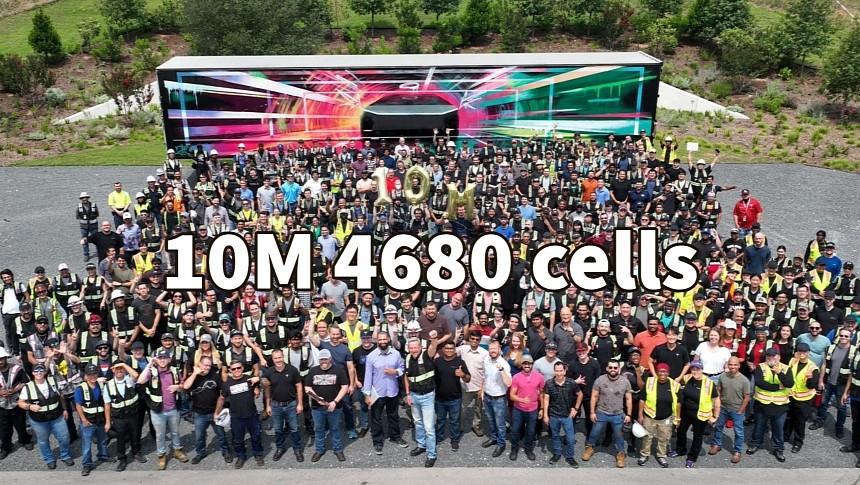Tesla celebrated an important 4680 cell production milestone, with the 10 millionth cell produced at Giga Texas. Although the number sounds impressive, it is still insufficient for mass production. You could power about 11,500 EVs with that entire production, which is not very much.
Tesla bet its future on the bigger cell form factor that is now known as 4680 based on its diameter (46 mm or 1.81 inches) and height (80 mm/3.15 in). When it introduced the new cells during Battery Day in 2020, Tesla promised a revolutionary Li-ion cell with improved chemistry and a manufacturing process that would shave production costs by over 50%.
One year later, the cells proved to be just bigger ordinary cells with no chemistry advantages. Tesla is still working hard on the dry battery electrode manufacturing process, which is a hard nut to crack. Without it, the new form factor makes little sense, as it would lead to more space waste inside the battery pack and, thus, lower energy density. This was proven after Model Y started shipping with the 4680 cells from Giga Texas.
Tesla was confident that the 4680 cells would finally prove their superiority and stopped investing in 21700-cell production. This led to production bottlenecks, as Elon Musk admitted when discussing Tesla Semi production numbers. The Tesla Semi might be a niche product, but the Cybertruck, the other new model that relies on the 4680 cells, is anything but. Cybertruck production start is also said to have been affected by the shortage of 4680 cells.
The production of 4680 cells at Tesla's Fremont pilot production facility and Giga Texas has steadily increased during the past months, but it's still far from covering Tesla's production needs. Last December, Tesla announced that it reached a production capacity of 868,000 cells per week, enough to build 1,000 cars per week. This figure covered the Fremont facility and the Giga Texas production, with the latter probably responsible for a smaller number of 4680 cells.
Tesla celebrated the 10 millionth 4680 cell produced at Giga Texas, which sounds like an impressive milestone. Based on Tesla's previous announcement, this should cover the battery pack production for about 11,500 EVs, which is not very much. This is the entire cell production since Giga Texas started manufacturing cells a year ago. Tesla will need this quantity produced weekly to have enough cells for the Cybertruck production through next year.
Tesla recently announced building another 4680-cell factory in Nevada, with a targeted annual production capacity of 100 GWh, or 1.5 million EVs with a battery capacity of 67 kWh. This is the battery capacity of the 4680 Model Y produced at Giga Texas. Tesla also urged its partners Panasonic and LGES to accelerate their 4680 cell plans, but that doesn't appear to go as planned. Panasonic recently announced delays to its program until next year.
One year later, the cells proved to be just bigger ordinary cells with no chemistry advantages. Tesla is still working hard on the dry battery electrode manufacturing process, which is a hard nut to crack. Without it, the new form factor makes little sense, as it would lead to more space waste inside the battery pack and, thus, lower energy density. This was proven after Model Y started shipping with the 4680 cells from Giga Texas.
Tesla was confident that the 4680 cells would finally prove their superiority and stopped investing in 21700-cell production. This led to production bottlenecks, as Elon Musk admitted when discussing Tesla Semi production numbers. The Tesla Semi might be a niche product, but the Cybertruck, the other new model that relies on the 4680 cells, is anything but. Cybertruck production start is also said to have been affected by the shortage of 4680 cells.
The production of 4680 cells at Tesla's Fremont pilot production facility and Giga Texas has steadily increased during the past months, but it's still far from covering Tesla's production needs. Last December, Tesla announced that it reached a production capacity of 868,000 cells per week, enough to build 1,000 cars per week. This figure covered the Fremont facility and the Giga Texas production, with the latter probably responsible for a smaller number of 4680 cells.
Tesla celebrated the 10 millionth 4680 cell produced at Giga Texas, which sounds like an impressive milestone. Based on Tesla's previous announcement, this should cover the battery pack production for about 11,500 EVs, which is not very much. This is the entire cell production since Giga Texas started manufacturing cells a year ago. Tesla will need this quantity produced weekly to have enough cells for the Cybertruck production through next year.
Tesla recently announced building another 4680-cell factory in Nevada, with a targeted annual production capacity of 100 GWh, or 1.5 million EVs with a battery capacity of 67 kWh. This is the battery capacity of the 4680 Model Y produced at Giga Texas. Tesla also urged its partners Panasonic and LGES to accelerate their 4680 cell plans, but that doesn't appear to go as planned. Panasonic recently announced delays to its program until next year.
Produced our 10 millionth 4680 cell at Giga Texas this week! pic.twitter.com/0x2CNoDvCR
— Tesla (@Tesla) June 16, 2023







